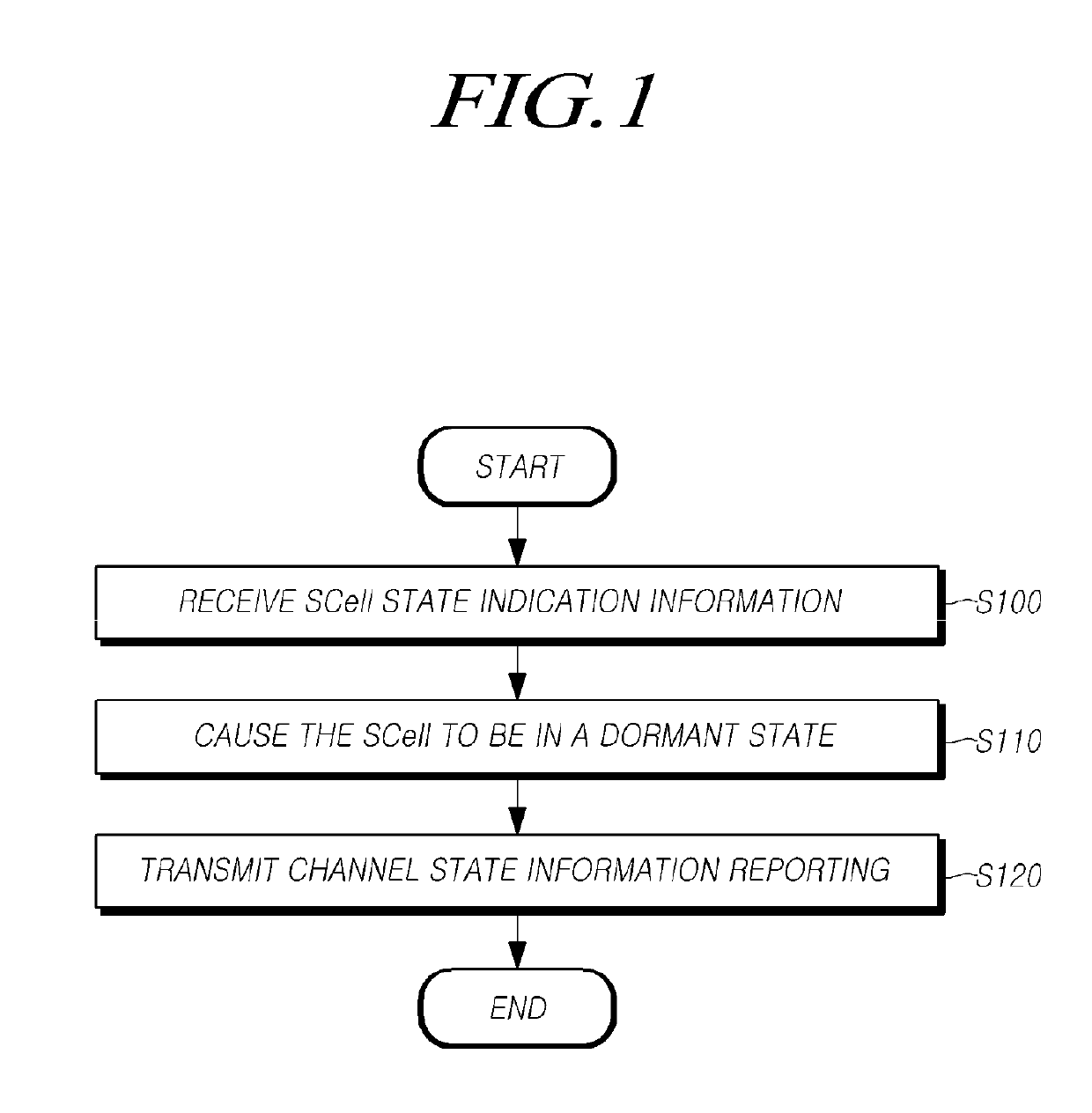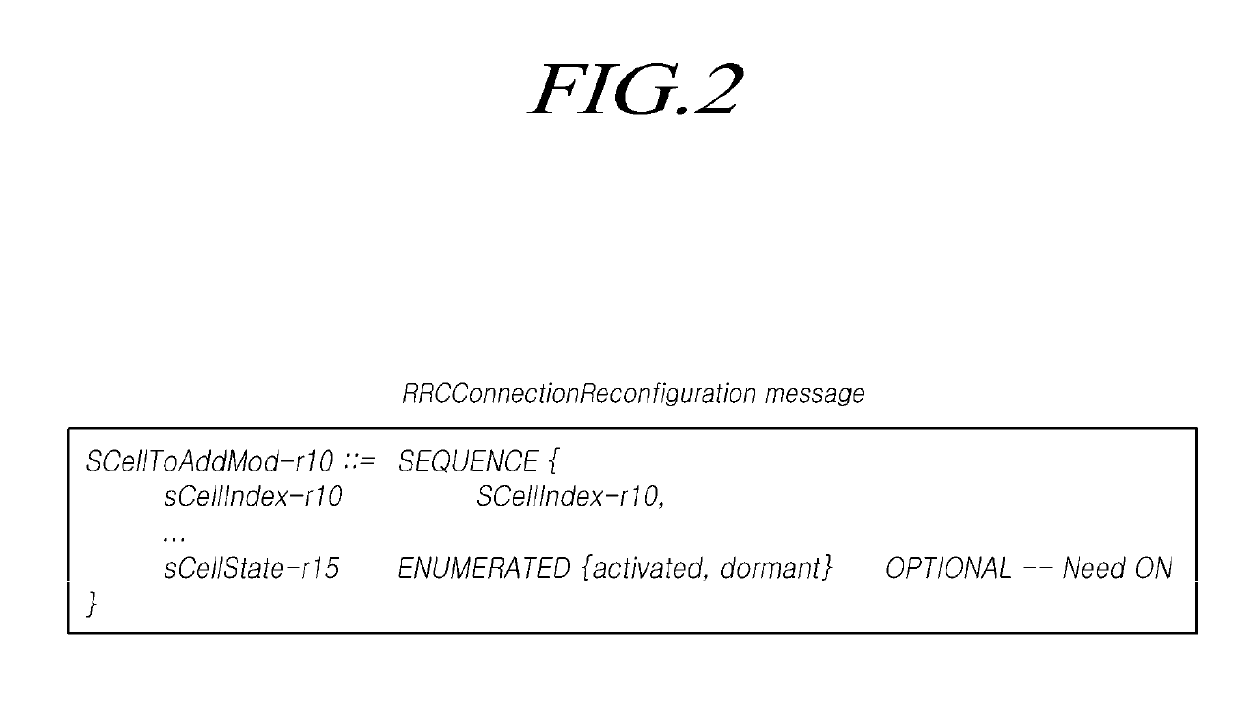Method and apparatus for controlling scell state
a control and state technology, applied in power management, transmission path division, high-level techniques, etc., can solve the problems of affecting the service satisfaction of users and networks, and affecting the service quality of users. achieve the effect of eliminating ambiguity of operations and performing operations quickly
- Summary
- Abstract
- Description
- Claims
- Application Information
AI Technical Summary
Benefits of technology
Problems solved by technology
Method used
Image
Examples
embodiment 1
Indicating the Dormant State Using a R Bit in the MAC CE Field
[0164]For example, the BS may utilize a typical activation / deactivation MAC CE (or a typical activation / deactivation MAC CE format) to indicate the dormant state for a SCell configured on a UE. For example, the indication will be given as follows.
[0165]The R field may be set to 1 to indicate the dormant state that is distinct from the activation state.
[0166]When the R field has been set to 1, the Ci field may be set to 1 to indicate that a SCell having a SCellIndex i shall be hibernated in the dormant state. As another embodiment, the Ci field may be set to 0 to indicate that the SCell having a SCellIndex i shall be hibernated. In this case, the Ci field may be set to 1 for indicating the remaining states.
[0167]When the R field has been set to 1, the Ci field is set to 0 to indicate that the SCell having a SCellIndex i shall be deactivated.
[0168]As another example, when the R field has been set to 1, the Ci field may be s...
embodiment 2
Indicating the Dormant State Using One (or a Specific Bit) of the Ci Fields in the MAC CE Field
[0172]For example, the BS may use a typical activation / deactivation MAC CE (or a typical activation / deactivation MAC CE format) to indicate the dormant state for a SCell configured on a UE.
[0173]As one example, one field or a bit in an activation / deactivation MAC CE may be used to indicate the dormant state that is distinct from the activation state. For example, the corresponding field or bit is set to 1.
[0174]As another example, one specific Ci in the activation / deactivation MAC CE may be used to indicate the dormant state that is distinct from the activation state. For example, the corresponding field or bit is set to 1 (or a dedicated value).
[0175]For example, a field or bit for indicating activation / deactivation may be configured on the UE through an RRC connection reconfiguration message. For example, information for indicating / enabling / configuring the operation may be configured on ...
embodiment 3
Indicating the Dormant State Using a Reserved LCID Value
[0181]As described above, for example, a new LCID distinct from the LCID of the typical activation / deactivation MAC CE may be assigned to indicate the dormant state.
[0182]In one example, the BS may utilize the same format as the typical activation / deactivation MAC CE, but assign a new LCID distinct from the LCID of the typical activation / deactivation MAC CE. For example, the indication will be given as follows.
[0183]Here, a SCell is assigned with a SCell index (SCellIndex) i, where “i” denotes an index of the SCell. A Ci field indicates the dormant state of a SCell having the SCellIndex i. Otherwise, the MAC entity shall ignore the Ci field. For example, the Ci field is set to 1 to indicate that a SCell having the SCellIndex i is required to transition to the dormant state. The Ci field is set to 0 to indicate that a SCell having the SCellIndex i is required to be deactivated.
[0184]As another example, the Ci field is set to 1 t...
PUM
 Login to View More
Login to View More Abstract
Description
Claims
Application Information
 Login to View More
Login to View More - R&D
- Intellectual Property
- Life Sciences
- Materials
- Tech Scout
- Unparalleled Data Quality
- Higher Quality Content
- 60% Fewer Hallucinations
Browse by: Latest US Patents, China's latest patents, Technical Efficacy Thesaurus, Application Domain, Technology Topic, Popular Technical Reports.
© 2025 PatSnap. All rights reserved.Legal|Privacy policy|Modern Slavery Act Transparency Statement|Sitemap|About US| Contact US: help@patsnap.com



